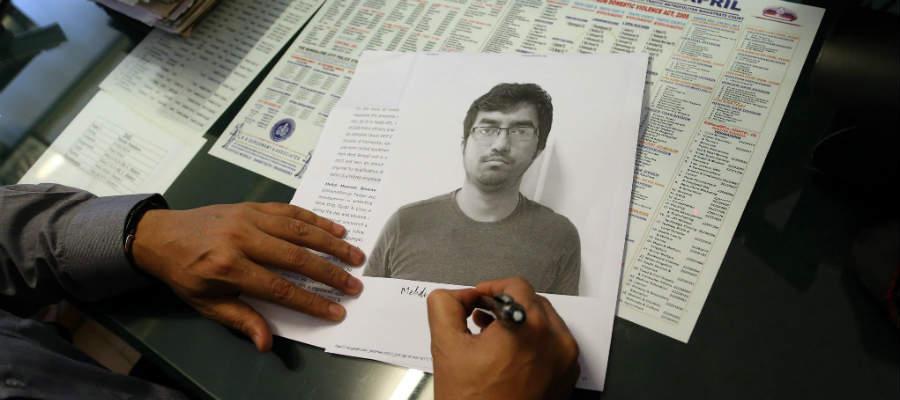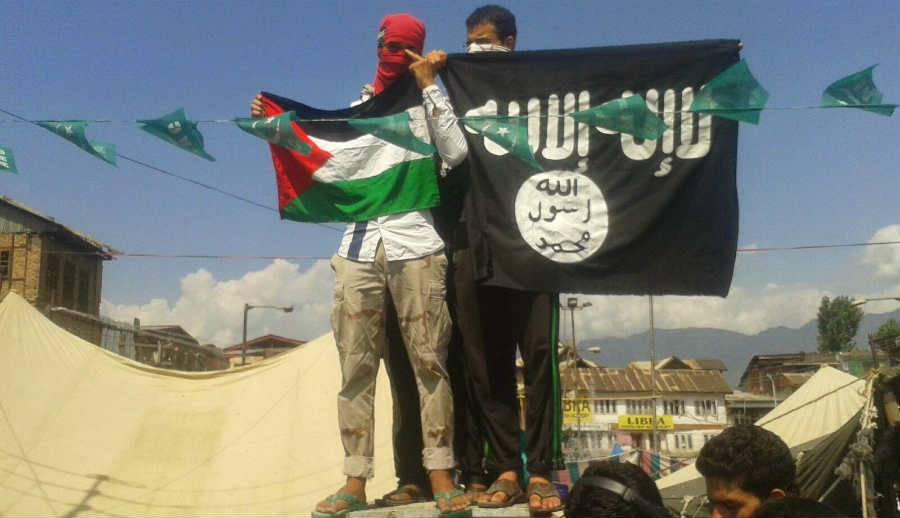This is the last part of the three-part series by Dr. Ajay Chrungoo, Chairman of the Panun Kashmir, a frontline organisation of Kashmiri Pandits. Dr. Chrungoo is a guest writer with Canary Trap.
BY DR AJAY CHRUNGOO
By far the most important aspect of illegal economy in Jammu and Kashmir, particularly in valley which has received minimum attention, is the introduction of fake Indian currency. During last decade the role of fake currency in impacting the socio-economic scene in Kashmir Valley is more than anything else.
Injection of fake currency seems to have crossed the boundaries of clandestine operations. It is becoming the part of socio-economic culture. While the drug trade, despite its enormous role in sustaining separatist campaign in valley, continues to be a social taboo in the public realm, the fake currency operating in valley does not carry the same connotations.
The interactions of people living in Jammu with Kashmiris in valley reveal the widening role of fake currency in the valley. A handicrafts trader, who after displacement shifted to Himachal, was casually told by his supplier in valley to use fake currency to increase the margin of his profits.
“How much do you earn in a month! Don’t you want to double your earnings?” Baffled he reported back, “You know it very well that our family has been doing this business for last six decades. We have done well by the grace of God. I have around 20 employees to pay. Yet I can’t imagine a way to double the earnings in my business in a short span of time. Are you talking about some magic?” He was stunned when he was told. “Take this currency (fake) and spend it gradually through your sale outlets. You will double your earnings.”
In an interaction during a party a gentleman boasted that he had during mid-nineties himself seen the money deposits from various post offices in valley done in a Jammu bank. “The post office official handed over a smaller bag to the official in the bank along with the deposits in the bigger bag.” The deposits in the bigger bag were perhaps in fake currency as per him and the money in smaller bag was genuine, meant for the officials involved in the racket.
Fake currency
Recently a gentleman had a very interesting anecdote to share. He had received Rs 30,000 from a Kashmiri Muslim in a business transaction. He went to deposit it in a bank. The notes he had received were all fake. The bank official immediately put him to enquiry. He revealed the source of the money to the bank officials. The Muslim businessman who had given the money was called to the bank premises. The businessman came to the bank with nonchalance and accepted that he had given the money to the person. While everybody else in the room was listening with amazement to his frank admission, the Khwaja got up, lifted the lid of the Bukhari (room heater) and put all the Rs 30,000 fake notes into it. He then turned to the bank official and told him that the matter was over now. Bank official thought it prudent not to report the matter to police. The gentleman who had gone to deposit the money confessed that he also felt obliged the way Khwaja relieved him of the trouble of further investigation.
These coffee table anecdotes may be exaggerations with a predominant subjective element. But all the same they provide an insight into the public discourse. Realistically they do not seem to be divorced from the hard realities which have come to the fore from time to time. On January 29, 2009, BSF seized Rs 33 lakh fake currency notes in Attari sector in Punjab along with 13 kgs of heroin. In November 2000, police arrested smugglers with heroin and fake currency Indian notes worth Rs 50,000 in Ferozpur, Punjab. In the same area a few days earlier two smugglers were arrested along with arms, narcotics and Rs 21 lakh fake currency notes. Four Kashmiri Muslim Youth were arrested on November 18, 2006 with Rs 3 lakh fake currency in the denominations of Rs 500 and Rs 1000 notes in Jammu city. The incidents of recovery of fake notes have been going on for years and are not a recent phenomenon. In January 2004, J&K police unearthed a mini composed unit of making fake currency in Trikuta Nagar from a police official’s son and recovered over Rs 34,000 fake currency Indian notes.
In February 2004 Delhi Police recovered fake currency worth over Rs 12 lakh from 3 persons. The equipment for printing was also seized. In March 2004, J&K police arrested three racketeers in Jammu city and recovered Rs 8.5 lakh worth fake currency from their possession. In December 2004 the Directorate of Revenue Intelligence seized fake currency with the value of Rs 46 lakhs and arrested four persons including two Bangladeshi conduits.
The injection of fake currency into Indian economy has started receiving some attention now. In August 2008, Uttar Pradesh police uncovered over Rs 4 crore worth of fake currency notes from two State Bank of India branches in Domariagunj. It was the largest seizure of high value currency notes and this forced a joint meeting of Intelligence Bureau, Directorate of Revenue Intelligence, the Ministry of Finance, the Central Bureau of Investigators, and Central Economic Intelligence Bureau in September 2008.
The meeting as per reports concluded that, “the problem had long slipped out of criminal activity and entered the realm of national security.”
As per estimates of Indian Intelligence leaks which have appeared in press from time to time in 2008, fake currency notes worth thousands of crores were being pumped into Indian economy per month. These notes are printed in currency printing press of Pakistan. Hence they are difficult to detect. The money earned from such ventures subsidizes the Pakistani economy. For Pakistan, economic subversion of India has become also a money minting venture.
While the role of illegal economy including fake currency has started attracting notice in rest of India, it is yet to attain the importance it deserves in the case of Jammu and Kashmir. This is despite the fact that regular seizures of narcotics, hawala money and fake currency note have taken place in Jammu and Kashmir from time to time. The issue becomes intriguing considering the fact that Jammu Kashmir continues to be the core target for the proxy war waged by Pakistan.
Army officials in J&K are on record of having said, “Earlier fake currency was handed out to allow terrorists to sustain themselves when they entered the valley. However in the past two years it has taken on a larger objective of hurting India’s economy.” Experts now admit that in Jammu and Kashmir, a mix of fake currency with genuine money is used by terror organization to pay their cadres and enlist clandestine logistic support from locals. It may be still an understatement. How fake currency and other illegal and crime economy is impacting the social milieu and affecting the legitimate productivity of the people is yet to be recognized as a crucial concern.
Professor Dipanker Sen Gupta of Jammu University comments on government policy and terrorist economy to highlight the paradox of low productivity and high consumption in the state.
“The state’s response to an economy damaged by militancy developed along predicted lines. As in North East India, the Central Government came in with packages aimed at reviving economy through grants intended to restore infrastructure as well as other parts of economy. The effect of all this was to create an economy whose State Domestic Product (SDP) defied common logic. The ultimate twist to this bizarre economic history was the revelation by National Sample Survey Organization that Jammu and Kashmir ranked highest of all states when it came to per household asset ownership in the country with Rs 10.87 lakhs per household.”
How is it possible in an economy ravaged by violence of worst kind?
The meat consumption in Kashmir is three times more than national average. The state has the capacity to meet hardly 30 percent of the demand of the meat for local consumption while it has to import nearly 70 percent from Rajasthan and Gujarat where consumption is said to be three times less than J&K. The state on an average is consuming meat of more than Rs 600 crores.
An interesting feature of the economic paradox came to fore in 2006 when the state accepted that despite referring 12,200 posts of Public Service Commission (PSC) and Subordinate Services Recruitment Board (SSRB) for advertisement, thousands of posts were lying vacant in different state government departments which include over 7600 gazetted cadre posts. How is it possible when all the respective governments have harped on unemployment as the main cause driving youth to militancy? The issue never received any public attention pointing subtly towards public involvement in such economic enterprises which are more lucrative than government jobs.
The percentage of population below poverty line in Jammu and Kashmir is 5.4 percent while the national average is 27.50 percent. The economic productivity in the state is going down. The contribution of Jammu and Kashmir to National Gross Domestic Product has decreased from 0.87 percent in 1999-2000 to 0.78 percent in 2005-06. The apparent affluence in the state and the unproductive economic status cannot be understood if interplay of illegal economy in the state is not factored into the policy making.
Illegal economy destroys entrepreneurship of society and creates a parasitic culture. The symptoms of such a state can be seen in Jammu and Kashmir. Uttar Pradesh Police, for instance, recognizes that the fake currency circulation is as high as 30 percent of the total currency notes circulation. The situation is being described as a national security threat. In J&K, despite the manifest role of narcotics, hawala money and fake currency in sustaining violence and instability, no definitive estimates of illegal economy are available. Experts say about fake currency that, “the absence of an established quantity of fake currency in circulation has led to regime of denial which has in turn prevented regulation.”
With the opening of LoC for trade one question which comes to the fore is that if the economic logic of such a trade does not suit separatists and Pakistan why do they support it?
Mirwaiz Omar Farooq gave a baffling statement about opening of cross LoC trade. “It is the first step towards Kashmir’s economic independence,” he said.
JKLF leader Yasin Malik said, ‘Freedom is closer’, after the opening of LoC trade.
The issue cannot a addressed unless there has to be a clear understanding about the importance which the pan-Islamist economic mafia attaches to the increased porosity of LoC in J&K in relation to drug grade, Hawala transfers and injection of counterfeit money.
The interest shown by Dubai based Kashmir Muslim traders in cross LoC trade has to be thoroughly analyzed. The implications of direct flight to Dubai as a starting point of international air traffic to Kashmir in the light of entrenchment of illegal economy in Kashmir needs to be looked from a wider perspective of economic subversion of India.
Click here for Bad money creates parasitic culture in J&K – Part 1
Click here for Bad money creates parasitic culture in J&K – Part 2


One Comment
No No No…. please don’t misunderstand Pakistan. They are only providing stimulus package for India during the global down turn…
Jokes aside… really interesting stuff man.